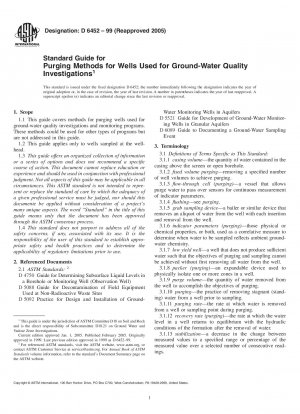ASTM D6452-99(2005)
Standard Guide for Purging Methods for Wells Used for Ground-Water Quality Investigations
- Standard No.
- ASTM D6452-99(2005)
- Release Date
- 1999
- Published By
- American Society for Testing and Materials (ASTM)
- Status
- Replace By
- ASTM D6452-99(2012)e1
- Latest
- ASTM D6452-18(2023)
- Scope
Wells used in ground-water quality investigations or monitoring programs are generally purged prior to sampling (Note 1). Purging is done to minimize the bias associated with stagnant water in the well, which generally does not accurately reflect ambient ground-water chemistry (Note 2).
Note 18212;Some sampling methods, such as passive sampling, do not require the practice of purging prior to sample collection (1,2).3
Note 28212;This guide does not address the practice of post-sample purging (purging again after sampling is completed), which is intended for purposes other than the minimization of bias associated with stagnant water in the well.
There are various methods for purging. Each purging method may have a different volume of influence within the aquifer or screened interval. Therefore, a sample collected after purging by any one method is not necessarily equivalent to samples collected after purging by the other methods. The selection of the appropriate method will be dependent on a number of factors, which should be defined during the development of the sampling and analysis plan. This guide describes the methods available and defines the circumstances under which each method may be appropriate.
1.1 This guide covers methods for purging wells used for gound-water quality investigations and monitoring programs. These methods could be used for other types of programs but are not addressed in this guide.
1.2 This guide applies only to wells sampled at the well-head.
1.3 This guide offers an organized collection of information or a series of options and does not recommend a specific course of action. This document cannot replace education or experience and should be used in conjunction with professional judgment. Not all aspects of this guide may be applicable in all circumstances. This ASTM standard is not intended to represent or replace the standard of care by which the adequacy of a given professional service must be judged, nor should this document be applied without consideration of a project's many unique aspects. The word "Standard" in the title of this guide means only that the document has been approved through the ASTM consensus process.
1.4 This standard does not purport to address all of the safety concerns, if any, associated with its use. It is the responsibility of the user of this standard to establish appropriate safety and health practices and determine the applicability of regulatory limitations prior to use.
ASTM D6452-99(2005) Referenced Document
- ASTM D4750 Standard Test Method for Determining Subsurface Liquid Levels in a Borehole or Monitoring Well (Observation Well)
- ASTM D5088 Standard Practice for Decontamination of Field Equipment Used at Nonradioactive Waste Sites*, 2002-01-10 Update
- ASTM D5092 Standard Practice for Design and Installation of Ground Water Monitoring Wells in Aquifers
- ASTM D5521 Standard Guide for Development of Ground-Water Monitoring Wells in Granular Aquifers (Withdrawn 2003)
- ASTM D6089 Standard Guide for Documenting a Ground-Water Sampling Event
ASTM D6452-99(2005) history
- 2023 ASTM D6452-18(2023) Standard Guide for Purging Methods for Wells Used for Ground Water Quality Investigations
- 2018 ASTM D6452-18 Standard Guide for Purging Methods for Wells Used for Ground Water Quality Investigations
- 1999 ASTM D6452-99(2012)e1 Standard Guide for Purging Methods for Wells Used for Groundwater Quality Investigations
- 1999 ASTM D6452-99(2005) Standard Guide for Purging Methods for Wells Used for Ground-Water Quality Investigations
- 1999 ASTM D6452-99 Standard Guide for Purging Methods for Wells Used for Ground-Water Quality Investigations
